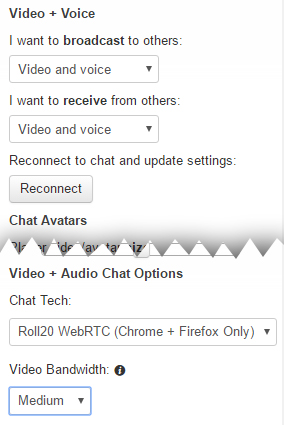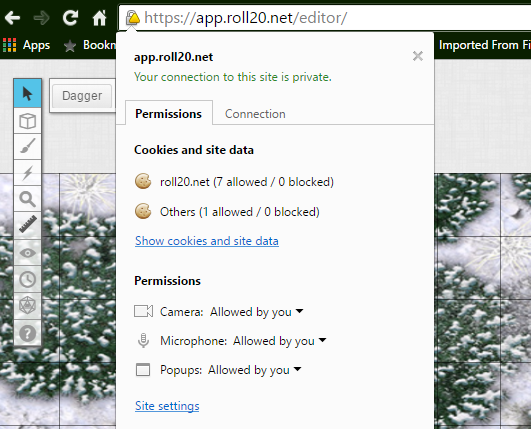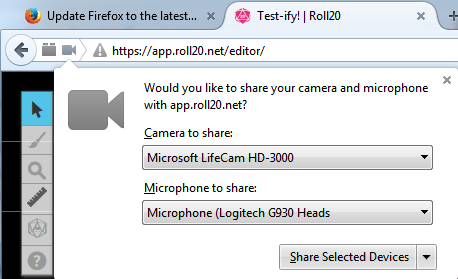Video and Voice Chat/Troubleshooting
From Roll20 Wiki
Contents |
WebRTC Basics
What is Roll20 WebRTC?
We at Roll20 believe that seeing and talking to your friends while you play is a vital part of the tabletop experience. WebRTC is a browser based VOIP option, allowing video and voice chat to be integrated into Roll20 without requiring you to download a 3rd party program or installing an add-on or plugin. While no other Virtual Table Top provides integrated video and voice chat, Roll20 is dedicated to offering it as a free feature. WebRTC's peer-to-peer nature allows us to provide that service as well as giving us the freedom to design advanced features, such as whispering, pop-out and adjustable videos, and more.
How is WebRTC different from Discord, Google Hangouts, Skype, etc?
WebRCT is a HTML5 technology that runs video and voice through a web browser without the need of a java applet. Applications like Skype or Discord aren't browser-based and therefore have access to hardware acceleration and data compression that Roll20 cannot take advantage of. Those applications use a Client/Server or All-to-One-to-All connection rather than a Peer-to-Peer connection. With an "All-to-One-to-All" connection, applications like Skype send your video/voice data one time to their server which then carries that load of data to each of the other people in the call. With "Peer-to-Peer", you are sending your video/voice data again to each peer connection in the call. This means that the upload bandwidth cost for a WebRTC call is higher than other VOIP options in anything more than a two person call. This higher upload bandwidth cost can result in stability problems for users with low upload bandwidth connections.
Roll20 WebRTC's Requirements
Roll20 WebRTC can only be used in web browsers that natively support it. Roll20's officially supported browsers Chrome and Firefox are both compatible. A Roll20 WebRTC call has a suggested download and upload bandwidth of 512Kbps per additional user in the chat. That means that in a six person call (five users other than yourself), you would need around 2.5Mbps of bandwidth for a stable call. If your group has members whose connections cannot support these requirements we suggest using a 3rd party, non-browser based chat option, that can make use of both hardware acceleration and data-compression to lower bandwidth requirements.
Roll20 Settings
Inside the Roll20 App, click on the Settings tab (gear icon), in the upper right hand corner of the screen. Under the Settings tab are different options that affects how WebRTC performs within a game.
Under the Video + Voice options make sure you've set Broadcast and Receive to your game's prefered choices (Video & Voice, Voice only, Video only). If there is more than one person currently in the game, individual changes made to either Broadcast or Receive require clicking on the Reconnect button in order for the changes to adhere for anyone else currently in the game.
For the GM, further down the Settings tab, under the "Game Settings" section, are "Video + Audio Chat Options". The GM should double check that the Chat Tech setting is not set to None.
Also in the "Video + Audio Chat Options" section, the GM can adjust the Video Bandwidth for the game. The setting can be set to High, Medium, Low, or Very Low. If one or more of your fellow players has a slower connection speed, you may want to set this to the lower Bandwidth settings to help with performance.
Firefox & Chrome Settings
At present, Roll20 only fully supports Firefox and Chrome web browsers for our VTT. Other browsers may be able to handle WebRTC with little to no issues, but we can't devote reliable tech support for them if you do run into any issues.
Keeping your Browser Up to Date
It's generally a good idea to keep your browser updated to take advantage of browser bug fixes and optimization measures.
Updating Chrome
- Click on the More Button (vertical row of three dots icon) in the upper right hand corner.
- Click on the Help option from the resulting drop down menu.
- Click on About Google Chrome option from the secondary drop down menu that appears.
OR
- Paste
chrome://help/into the URL bar and hit Enter.
Either method will open Chrome's "About" page that will inform you of your current browser version and will automatically prompt you to update to the latest stable version if you're not using it.
Updating Firefox
- Click on the Menu Button (three horizontal lines icon) in the upper right hand corner.
- Click on ? icon at the bottom of the drop down menu.
- Click on About Firefox from the resulting roll out menu.
- Firefox will tell you your current browser version and automatically prompt an update to the latest stable version if you're not using it. Click the Restart to Update button if necessary.
Microphone and Camera Browser Permissions
To protect your privacy, microphone and webcamera permissions are disabled from use on Chrome and Firefox by default. If this is the first time you've used Roll20, recently cleaned out your browser cookies/cache, or working from a fresh install of your browser, you'll need to approve the Roll20 website's use of your camera and microphone for them to be used for broadcasting either video or voice within a game.
Enabling Chrome Permissions

- When the VTT loads for the first time, you should be asked to Allow or Deny camera and microphone access from a grey bar pop-up that appears at the top of the screen.
- Click Allow to enable your camera and microphone to be used within a Roll20 game.
OR
- Click on the lock icon in the far left of the URL/search bar to reveal a drop down menu.
- Ensure that both Camera and Microphone options have their permissions set to "Always allow on this site". Make sure you're currently on Roll20.net when you set this, this setting is URL sensitive.
Enabling Firefox Permissions
- When the VTT loads for the first time, you'll be asked to 'Share Selected Devices' from a drop down menu in the upper left hand corner of the screen.
- If not, click on the Camera icon in the upper left hand corner next to the Back button.
- Be sure to select the correct Camera and Microphone to share before clicking the Share Selected Devices button.
Clear your Web Browser's Cache
Clearing Out Chrome's Cache
- Click on the Menu Button (three horizontal lines) in the upper right hand corner.
- Click on More Tools from the dropdown.
- Click on Clear browsing data from the new options.
- From the drop down "Obliterate the following items from:" select the beginning of time option.
- Check both Cookies and other site and plug-in data and Cached images and files.
- Click on Clear browsing data button.
Clearing Out Firefox's Cache
- Click on the Menu Button (three horizontal lines) in the upper right hand corner.
- Click the Options Button' (a small gear) from the drop down menu.
- On the Advanced tab, select the Network sub-tab.
- Under the Cached Web Content section, select the Clear Now button.
Device and Bandwidth Tests
Webcam WebRTC Compatibility Test
- Check to see if your camera works with Google’s WebRTC demo.
- Go to: https://apprtc.appspot.com
Alternatively is to run a test of your webcam and mic through appear.in. This website is also a Peer-to-Peer WebRTC service that can have up to eight users in a conference call. You can test your entire gaming group in one pass.
Perform a WebCam/Microphone Test
- Check if your camera works with a different browser. For instance, if you are using Firefox check if it works with Chrome instead.
- Does the camera work with any other software that uses the camera such as Skype or Photobooth.
Perform a Bandwidth Test
If you don’t already know them, you can take a bandwidth speed test from OOKLA’s Browser-based Speedtest (Note: Adobe Flash is required to run the applet). You will want to run this test in the principle environment you normally play your games on Roll20 and have a Roll20 game currently open.
- Once the applet loads on the home page, click the button "Begin Test".
- Allow the test to run. This process can take a couple minutes to complete.
- Once it's finished, Speedtest will give you your download and upload rate in megabits per second (Mbps).
Filing a Report on the Bug Forum
If none of the above tests and steps helped resolve your issues please follow Steps 1-3 from the Solving Technical Issues Guide, taking special care to temporarily disable all browser add-ons and extensions, temporarily pause your anti-virus (or whitelist Roll20.net), and try switching browsers (for Chrome/Firefox specific issues) to see if one of those components is causing the problem. If all of that fails, please follow Step 4 and file a bug report on the WebRTC Video and Voice Chat Issues forum thread. Please provide all of the information you gathered from Steps 1-4 of the Solving Technical Issues Guide as well as the following information:
WebRTC Connectivity Diagnostic Test
Additionally, we recommend that you try to run this WebRTC Connectivity Diagnostic Test and supply its test result in your report.
Once there:
- Click on the Start button.
- Allow the test to run itself through the various subtasks (Microphone, Camera, Network, Connectivity, and lastly Throughput).
- If the test runs into any issues, click on the bug icon at the top, this brings up a new window to create a bug report.
- Describe what issues you had with the diagnostic test and then click on “Upload Report”
- This will pull up a new window that provides a link to the report (“The link to the report is now available”). This link will be available for the next 90 days. Copy the link and paste it here in this thread.
In-Game Bandwidth Settings
Let us know what your average Download and Upload speeds from the above Bandwidth Test as well as the "Video Bandwidth" setting (High, Medium, Low, or Very Low) under the Video + Voice section of the Settings tab within your Roll20 game.












